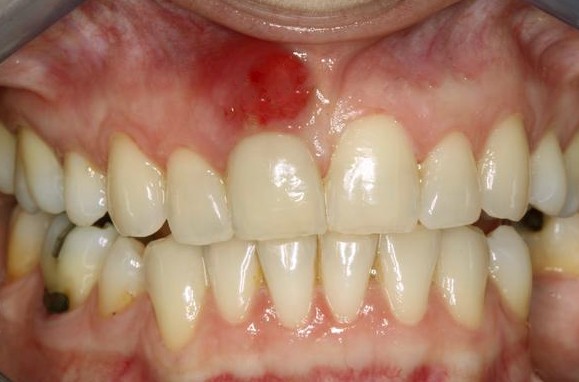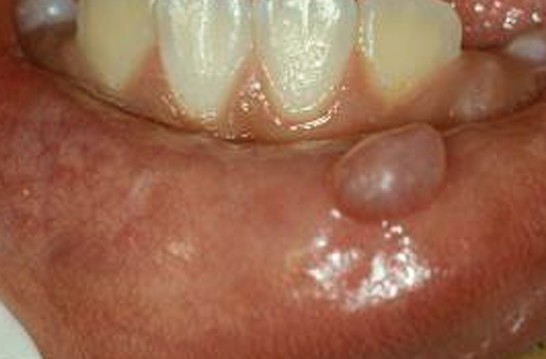Lump on Gums
When people notice a lump on their gums, the first tendency is to worry. However, this modification does not necessarily equal a serious health problem. Instead of spending your time worrying about it, it is for the best to go to the doctor. A medical professional can make an accurate diagnosis, based on your symptoms. In many situations, the lump is caused by a bacterial infection or a dental abscess. If the problem is caused by an infection, it is for the best to visit the doctor as soon as it is possible. Left untreated, this infection can enter the bloodstream and lead to sepsis (generalized infection).
Symptoms of Lump on Gums
These are the most common symptoms that are associated with the lump at the level of the gums:
- Pus formation (infection)
- Pain or tenderness (sometimes the patients describe a throbbing sensation in the lump area)
- Inflammation
- Fever (suggestive of a more serious infection)
Pictures of Lump on Gums

Picture of Hard lump on gums

Picture of painful soft lump on gums

Picture of White lump on gums with pus
What Causes a Lump on Gums?
These are the most common causes that may lead to the appearance of such a lump at the level of the gums:
- Gum irritation
- Common in people who grind their teeth
- Repeated friction leads to such problems
- Irritation can appear as the response of the immune system (form of protection)
- Canker sore
- Often caused by a spicy diet
- May also be seen because of infectious factors
- White, pink or red in color
- The lump is painful upon touch (with the tongue)
- Gingivitis
- Inflammation of the gums
- The gum tissue presents one or more lumps (progressive condition)
- Often found in association with bacterial overgrowth
- Can lead to tooth loss if left untreated
- Dental problems
- Most common – tooth abscess
- Pus forms at the level of the gum, leading to the appearance of the lump
- Because of the infection, the gum suffers from an inflammation process (more prominent lump)
- Dental treatments
- Most common – dental extraction
- Lump can be represented by the blood clot resulting from the hemorrhage, caused by the actual dental extraction
- The lump can also appear because the gum was irritated, as the result of the dental extraction
- Other causes
- Oral cancer
- Local trauma or injury
- Hormonal changes (pregnancy).
Diagnosis
These are the most common methods for diagnosing the type of lump that is present at the level of the gums:
- Medical history of the patient
- When did the lump appear for the first time
- Other symptoms (bleeding gums, inflammation)
- Similar problems in the past
- Family medical history (risk of oral cancer)
- Chronic smoker or not (smoking – higher incidence of gingivitis and other dental problems)
- Dental examination
- Identification of tooth abscess
- Imaging studies
- Dental X-ray – confirm the type of lump (gum irritation, abscess etc.)
- CT scan or MRI – performed in the situation that there is a suspicion of oral cancer (better visualization of the tissues)
- Biopsy
- Often performed at the same time with the removal of the lump
- Can confirm whether the removed tissue is of malignant or benign origin, guiding the doctor towards the right treatment measures.
Treatment for Lump on Gums
These are the treatments recommended for the lump at the level of the gums:
- Anti-inflammatory medication
- Recommended choices – naproxen, ibuprofen, acetaminophen
- Oral administration
- This medication should be administered with care in those who suffer from chronic liver disease
- Antibiotic treatment
- Recommended in case of bacterial infection
- May be administered before or after a dental treatment
- The treatment has to be taken for as long as it is prescribed, otherwise the bacteria will become resistant to the respective antibiotic
- During the treatment with antibiotics, it is recommended that one takes probiotic supplements, so as to maintain a healthy intestinal flora
- Surgical intervention
- Often performed in the dental office
- Most common – root canal
- Also possible – tooth extraction or other surgical interventions (periodontal surgery)
- Surgical removal of lump – recommended when there is a suspicion of oral cancer (the biopsy will be performed at the same time with the removal).
- Chemotherapy and/or radiation therapy
- Recommended in patients who have been diagnosed with oral cancer
- May be performed before or after the surgical intervention, so as to increase the chances for survival.
Home remedies
These are the most common home remedies recommended for such problems:
- Saline solution
- Salt water rinse – disinfecting properties
- Also brings the necessary pain relief, especially in combination with clove oil
- Mouthwash
- Antiseptic and antibacterial properties
- Can be also used for prophylactic measures.
When should you consider going to the doctor?
In the situation that the lump at the level of the gums prevents you from properly chewing or speaking, you need to go the doctor. The same goes for the situation in which you experience intense pain and inflammation at the level of the jaw, as you might be suffering from a serious infection. Other signs that you make you consider a visit to the doctor include bad breath, bleeding at the level of the gums or fever.
How to Prevent of Lump on Gums?
As you have probably understood, often times the lump at the level of the gums is caused by dental problems. You can prevent such matters by maintaining an excellent oral hygiene. That means you have to brush and floss on a daily basis, not to mention visit the dentist on a regular basis (every six months). Keep in mind that, when it comes to dental problems, it is far easier to prevent than treat.
You should also think about the type of toothbrush that you use, avoiding those that have an irritating effect on the gums. Electric toothbrushes are more recommended, as they guarantee a thorough cleaning of the teeth, without irritating the gums. Also, it is important to change the toothbrush regularly, so to prevent getting an infection from your own toothbrush. Do not cover your toothbrush or keep it in a container, as the excess humidity will only promote bacterial overgrowth.
In regard to risk factors, be sure to quit smoking, as this is one of the most common habits associated with a high incidence of gum disease. It is a known fact that chronic smokers suffer from inflamed and bleeding gums, so be sure to quit this habit as soon as it is possible. Apart from the dental problems that smoking can cause, it also increases the risk for oral cancer, so be sure to keep that in mind.